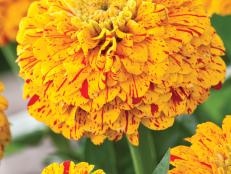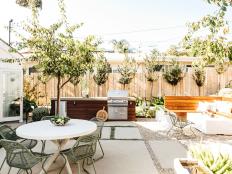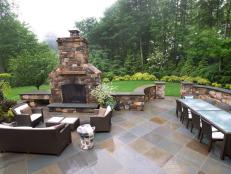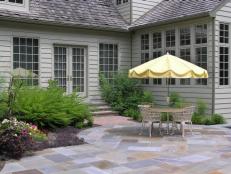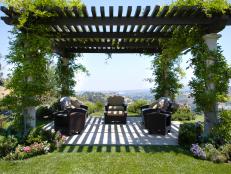Plants for Your Patio

Patios are ideal for landscaping with container plantings. They are easy to maintain and you can change out the plants for to extend the bloom time from spring well into the fall. In warmer climates, many container gardens can be left out all year long and will continue to provide color and interest for months. All that's required is that you choose plants that are well suited to your area and give them plenty of room in big pots to thrive.

Strategically placed containers can also be used to delineate the different areas on your patio. A pair of urns flanking the walkway leading to the patio marks the entrance and guides visitors where to walk to access the patio.
"Consider height when designing your patio containers," says Robert Welsch, landscape designer of Westover Landscape Design. "Large containers that can accommodate a small tree can help enclose the space and create screening for privacy."
Containers placed at the edges of the living area or dining area visually separate these spaces making them feel cozy and intimate. "Consider height when designing your patio containers," says Robert Welsch, landscape designer of Westover Landscape Design. "Large containers that can accommodate a small tree can help enclose the space and create screening for privacy."
Robert suggests multi-stem river birches planted in large 20-inch square tree cubes from Diamond Teak. "They have a graceful flow and look," he says. Up lights lit at night will highlight their exfoliating bark. Use boxes of Japanese maples and Redbud trees for patios, or any tree that will become a dwarf by putting it in a box. For a classic, formal setting, use plant boxwoods in containers.
For areas with a view you would like to screen out, a living wall may be the answer. Woolly Pockets are made of fabric bags that hold soil and water so the plants stay moist. They hang on a fence or trellis and can be planted with ferns, ligularia and crotons in a shady area or sedums, dianthus and creeping varieties of thyme and oregano for sunny spots.
"So often, a patio looks separate from the rest of the landscape," says Greg Stone, landscape architect of Greg Stone Landscape Architect. He suggests planting your patio containers with plants that relate to the plants around it.
If you have succulents in your garden beds then plant smaller succulents in the pots on your patio. Plant some of the same perennials you have in the garden into pots on the patio. That way, you can see the color and texture of the plants up close. "Choose hardier plants," Greg says. "It’s less painful than growing tender plants that end up looking bad later in the season."
And ask yourself how much maintenance you are willing to do, says Monica Mroz, landscape architect, of Monica Mroz Landscape Architect. Some plants require deadheading of spent flowers to encourage more bloom and regular trimming to keep them in check. Be realistic. Is that really something you want to do? Monica suggests choosing non-prickly varieties and durable plants that will not overgrow the space. "Be aware of their ultimate size at their full growth," she says.
Patio Plants
See All PhotosAnother reason to plant container gardens on your patio is that plants spilling out of containers help to soften the hard surfaces of large expanses of stone."Stage pots together for lots of texture and color," says Robert. You'll blend the green spaces such as lawn and garden beds with the hard patio space. Near the cooking area of the patio, containers planted with edibles such as herbs and vegetables, offer fresh ingredients within reach.
Annuals are the perfect choice for patio containers. They live their entire lives to bloom and set seed in the warm summer months and perform well in big pots. They are reliable, long bloomers providing color throughout the growing season.
Perennials work well in containers. They generally have a shorter bloom period but if taken care of and will return year after year to provide seasonal blooms during the growing season. Perennials need to be divided about every three years to keep them blooming. The extra plants you get from dividing can go into the garden landscape directly in the ground.






